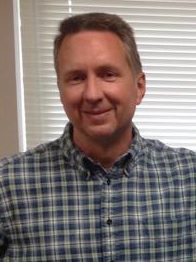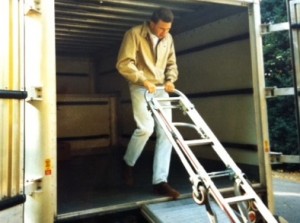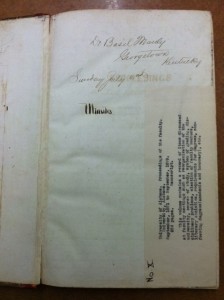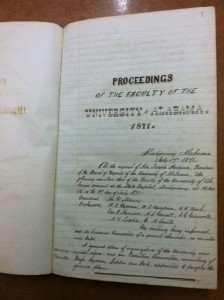Tom Land, the Institutional Records Analyst in the Division of Special Collections, is retiring at the end of this month after over twenty years of service. This interview is between Amy Chen, the editor of Cool@Hoole, and Tom Land.
First off, congratulations on your upcoming retirement!
Thanks, I can’t believe it’s finally here. I was a young punk and the other staff members were at least in their 40s when I first started working here. At some point, I don’t remember when, I became the old guy with the institutional memory. I can now pass the mantle of “Old Man of Special Collections” to Kevin Ray.
Would you mind telling us when you first started working in the Division of Special Collections and what originally got you interested in the field of rare books, manuscripts, and university archives?
I guess, in a way, I kind of stumbled into Special Collections. I had worked as a student in the History Department for two years and then in Gorgas Library for another two years. A professor I worked for in the History Department, Russell Bryant, asked if I would be interested in a job in Special Collections. I had met the Curator of Special Collections, Joyce Lamont, while working at Gorgas and I heard she was a great department head. I also loved history and the University, so I applied for the records clerk job. Dr. Bryant gave me a recommendation and Joyce hired me in September of 1986.
How has the Division of Special Collections at The University of Alabama changed over the years?
Typewriters. When I started working in Special Collections we used typewriters, we barely even knew what PC (personal computer) meant. By 1988 I grew tired of the typewriters and decided to use a computer database (yes, it was the Atari Trimbase) to produce finding aids and to track records checked-out in University Archives. Our Archival Technician, Joe Moudry, helped me get started. We were really cutting edge. I say that with some sarcasm, but all the data I entered back then on the Atari has been migrated to other systems over years and we still use that information today.
The other big change is our facilities. The University Archives were stored in the Gorgas attic and the temporary records were stored in four attics around campus. We now have clean, climate-controlled facilities for both archives and records management. Having worked closely on a daily basis with a wide variety of bugs in the dust of the attics for the first half of my career, I really appreciated being able to work in facilities that were built to house a library or an archive.
What is your present role in the Division of Special Collections?
My title is Institutional Records Analyst. I work with University offices and departments to identify, preserve, and provide access for their archival records. Additionally, I work with the storage of and eventual destruction of their temporary records.
Amy, I have a question for you. Who is the only UA president to play in the Alabama football spring game?
Oh, so you are turning the tables on me? I see how it goes. I don’t know! But the answer will be at the end of the blog.
What’s your favorite record group within University Archives and why?
I think the older faculty minutes and the Board of Trustees minutes, from the University’s founding through Reconstruction, are both very interesting. There really are not many records from that time period, and they document the time period in a different manner than the newspaper accounts of the day.
What do enjoy most about your role?
I always enjoy working with students, but I especially enjoy working with writers, since they go into greater depth in their research and they visit Special Collections often. Over the last few years I really enjoyed working with Delbert Reed, David Briley, Earl Tilford, and Sarah Wiggins on their various projects. It was always interesting to discuss their project with them and then to find everything I could for them in the archives. I also delighted in the daily tidbits that Jim Ezell would find searching newspapers while working on his book The Ferryman’s Last Trip. And last, but not least, my friend Gene Ford who would come in just about every Thursday to research a historic building. He looked at so many Sanborn Fire Insurance Maps that we called it “Sanborn Thursday.” In all seriousness, the Sanborn Maps are a wonderful source of information since they so detailed. The Sanborn Maps are available on the Alabama Maps website and here at Special Collections.
Could you describe one of your favorite experiences from your time working in the Division of Special Collections?
Last year, our two new staff members, Patrick Adcock and Gates Winters, were training on the reference desk. Our more experienced staff had explained all the policies and procedures to them. We also had worked with them on common research sources for patrons. On their first day working the reference desk alone, I sent my 16 year old daughter and my wife in as fake patrons. My daughter was to pretend she was a college freshman working on a paper about UA presidents, and then my wife would come in and ask for old city directories. Patrick was the first staff member on that morning. Well, everything worked perfectly. My daughter and wife carried out their roles without a hitch. Patrick pulled the UA Pictorial History for my daughter and then a Polk City Directory for my wife. He had passed his first test, but later he told about what he was thinking. He said “when that freshman walked in, my mind went blank – oh no, what is she going to ask me?” The thought of a big guy like Patrick worrying about what a skinny little 16-year-old is about to ask is funny, but we have all had that “oh no!” moment first day on the job. I have always enjoyed training new staff and interns and helping them get through that first day.
Trivia Answer: Joab Thomas. In the mid 1980s Coach Ray Perkins had the current team play a team of UA alums who were former football players. It was usually a good game with recent graduates and former NFL players making up the roster. In the 1985 A-Day game UA President Joab Thomas entered the game as a running back. Dr. Thomas had played running back in high school, but in 1985 he was in his fifties and had lost a step or two. He ran a toss sweep to the right side of the field and was swarmed by All-American Cornelius Bennett and others. Coach Perkins had told the players, “Tackle him, but don’t kill him.”
Thank you, Tom. It’s been a pleasure being your colleague and all of us at Hoole wish you the best in the future.





One Response to Interview with Tom Land, Institutional Records Analyst